Vega Vox models I-IV, high end plectrum and tenor banjos, can trace their Boston beginnings back to the Jazz Age 1928 Vega catalogue. The penultimate Vega Vox V was designed for banjo wizard and consummate showman Eddie Peabody (1902-1970) in the late 1960`s. Although the American Banjo Museum in Oklahoma City does not have a rare Vega Vox V, it has a Model IV donated by Peabody`s son George. The glitzy ” Vox-Ultra V” model first appeared in the 1972 Vega Martin catalogue as an end note on a back page devoted to “Special Models”. In the 1976 Nazareth, PA, product brochure, the Vox-Ultra V plectrum/tenor banjo occupied a full page with its photos and descriptor. 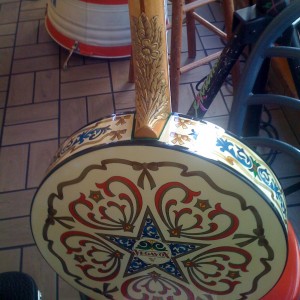
This flashy 4 stringer featured an engraved and hand-painted deep resonator with similar appointments on the peg head. It had a brass tone ring and engraved chrome armrest. The Vega Vox V sported a gold plated tension hoop and flanges bejeweled with 24 rhinestones. Engraved mother of pearl inlays figured the fretboard, and still more rhinestones studded the rococo peg head.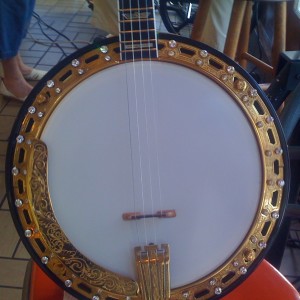
The Vega Vox V banjo SN 130316, shown here, was manufactured 1971-72. There were only a handful of these spectacular instruments ever made, and this one was rescued from overseas in an exhausted condition in recent years.
It was returned stateside to be professionally and meticulously restored, and it is one of the few such marvelous relics extant.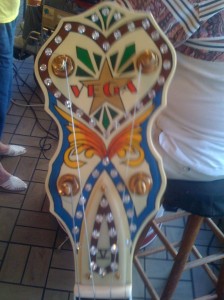
Deering now owns the Vega brand and is contemplating re-introducing the Vega Vox banjo series. Vintage Vega Vox models I-IV were manufactured in Boston for decades and not infrequently come-up for sale online. The Vox-Ultra V, however, will remain an endangered species until Deering resurrects it. For a detailed history, click-on the above Vega Martin Banjo Info header and scroll down the mailbox to post (#26) for Dr. Ron`s extensive Comments, and the BRC thanks him for the historic details and photos.

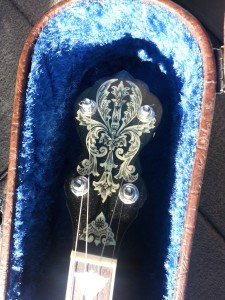
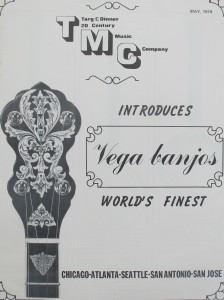
6 Comments
Can I turn my Vega tenor banjo into a 5 string, and find a pretty neck similar to my 4 string SN# 2441 ? THANKS
Aaron- Converting tenor banjos into 5 stringers is a long tradition, although much more frequently done years ago when few 5 string banjos were on the market. As I do regularly in my workshop, you might find a suitable 5 string neck on Ebay and do the conversion yourself, if you have the skills and tools. Or, have a luthier do it for you. Do not discard the original tenor neck, as it has resale value with the original pot. Your SN 2441 puzzles me. Do you know the model of your instrument , and can you estimate the year of its manufacture? Is “C.F. Martin, Co.” imprinted on the back of the peghead or on the inner aspect of the pot? Good luck with your conversion project, and I would love to know more about your banjo. Photos would be welcome.
Later……
Aaron- Thanks for the prompt photos. Your Vega 4 string banjo was made after Martin sold the brand name overseas to Galaxy Trading Company in 1979, and Galaxy marketed their newly acquired line of banjos in the USA through TMC (Targ & Dinner 20 Century Music Company) distributors. In the TMC catalogue, the listed instruments only had item numbers but no model names like “VIP” or “Folk Wonder” from the Martin era. Your top-of-the-line 4 stringer is item # VT2PC and retailed for $1200 circa 1979, and its ornate peg head is pictured above alongside the TMC cover photo of its new Vega catalogue. The engraving and inlay is highly detailed, so you might think twice about remodeling the instrument. An option might be to sell it on Ebay and reinvest those funds into a nice 5 string banjo. In any event, good luck with your banjo plans and thanks again for the photos. From the BRC, Barry
I have acquired a Vega tenor (Pro?) with the same headstock details as the photo above and I’m having trouble dating it (and knowing the precise model). Can anyone help? It’s got a beautiful wood resonator with a tiny “vega” in the center circle. Thanks.
Stew- Thanks for your query. My presumption is that you are referring to the black and white banjo headstock in the case lined with blue velvet. The May 1979 Vega catalogue was marketed in the US by TMC (Targ & Dinner 20 Century Music Company) for the Galaxy Trading conglomerate in Asia who had recent bought the Vega brand from C.F. Martin. The catalogue lists the aforementioned 4-string plectrum banjo with classic “Appointments similar to old style Vega Tu-Ba-Phone No. 9.” The 4-stringer was Item # VT2PC and retailed for $1200. In general, plectrums have 22 frets, and tenors have 17-19 frets. You are welcome to send photos as needed, as it sounds like you have a swell 4-stringer. Thanks again for your post, Barry
How does the dumbell openings in the tone ring compare in sound to the original round hole vegavox tone ring?
Ron – Your question is a vexing issue, as a banjo`s tone ring is central to the voice of the instrument. Vega designed the Tubaphone tone ring with its multiple evenly spaced drill holes circa 1906. Waverley was subcontracted to manufacture this tone ring for Vega from 1915 till bankruptcy in the 1960`s. With the folk music revival gaining momentum in the late 1950`s, the tonal response of the Gibson Mastertone was deemed by many as the touchstone of banjo performance. Vega soon began experimenting with variations of their traditional Tubaphone tone ring to be able to market it as a “new and improved” design feature of their `tone chamber` hoping that this product upgrade would compete with the Mastertone. The dogbone/dumbell drill holes with slits or slots connecting them were commonly seen in the Vega Pro II model as cited in its 1966 catalogue, but these `audio apertures` and other variations appeared somewhat randomly in other product lines thereafter. The Vega Martin VIP banjo had its unconnected drill holes grouped in clusters of three. If you surf the banjo chat rooms online for comparative comments regarding the sundry configurations of drill holes and connecting open seams in the Tubaphone tone ring, you will find that the comments vary widely. Sonic beauty is, of course, subjective and in the ear of the beholder. My 1975 Vega Martin VIP 5-stringer has an almost warm mid range tonal response compared to my Gibson Mastertone 1928 archtop which is bright and powerful. My sense is that the alloy, weight, and design of a tone ring are probably more important than the type of drill holes in it. Hope this helps. From the BRC, Barry